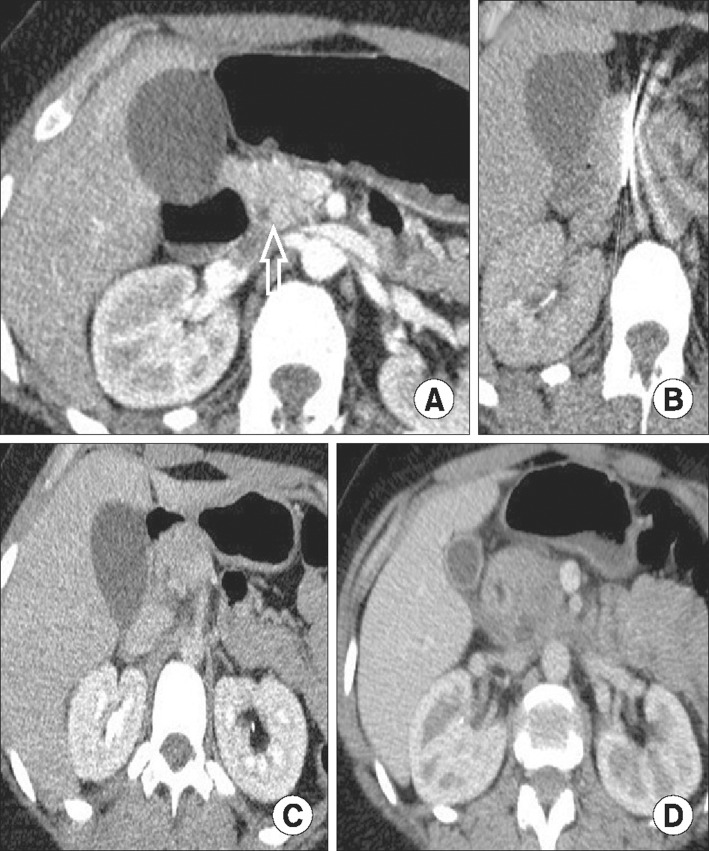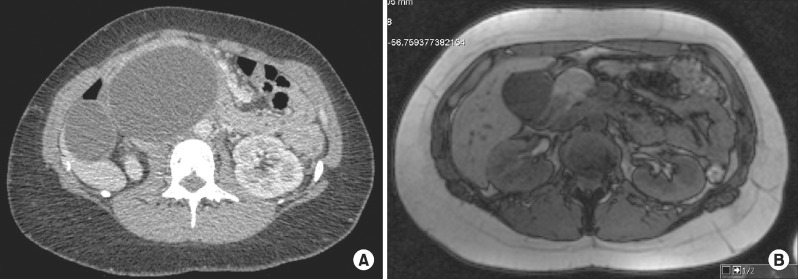Korean J Hepatobiliary Pancreat Surg.
2016 Aug;20(3):116-120. 10.14701/kjhbps.2016.20.3.116.
Irreversible electroporation for the treatment of pancreatic neuroendocrine tumors
- Affiliations
-
- 1Institute of Liver Studies, Kings Health Partners at King's College Hospital NHS Trust, London, United Kingdom. nigel.heaton@nhs.net
- KMID: 2351298
- DOI: http://doi.org/10.14701/kjhbps.2016.20.3.116
Abstract
- BACKGROUNDS/AIMS
Resection or enucleation is currently the treatment of choice for small pancreatic neuroendocrine tumors (NETs). Irreversible electroporation is a novel ablative method that is used for locally advanced pancreatic adenocarcinoma, but little data exists for its use for pancreatic NETs. We report an early experience of IRE for early pancreatic NETs.
METHODS
Between April 2014 and March 2015, 3 patients with small (<2 cm) pancreatic NETs were treated with percutaneous IRE.
RESULTS
There were no adverse effects during the procedure. Mean hospital stay was 2.6 days. All patients remained disease free on 12-19 months follow up. One patient developed recurrent pancreatitis with pseudocyst formation.
CONCLUSIONS
IRE for small tumors of the pancreas is practical and may offer advantages over other thermal ablative techniques, since it preserves vital structures such as blood vessels, bile and pancreatic ducts. Further data regarding the long term disease free interval is required to establish efficacy.
MeSH Terms
Figure
Reference
-
1. Fesinmeyer MD, Austin MA, Li CI, De Roos AJ, Bowen DJ. Differences in survival by histologic type of pancreatic cancer. Cancer Epidemiol Biomarkers Prev. 2005; 14:1766–1773. PMID: 16030115.
Article2. Yao JC, Hassan M, Phan A, Dagohoy C, Leary C, Mares JE, et al. One hundred years after "carcinoid": epidemiology of and prognostic factors for neuroendocrine tumors in 35,825 cases in the United States. J Clin Oncol. 2008; 26:3063–3072. PMID: 18565894.
Article3. Baur AD, Pavel M, Prasad V, Denecke T. Diagnostic imaging of pancreatic neuroendocrine neoplasms (pNEN): tumor detection, staging, prognosis, and response to treatment. Acta Radiol. 2016; 57:260–270. PMID: 25855665.
Article4. Bilimoria KY, Tomlinson JS, Merkow RP, Stewart AK, Ko CY, Talamonti MS, et al. Clinicopathologic features and treatment trends of pancreatic neuroendocrine tumors: analysis of 9,821 patients. J Gastrointest Surg. 2007; 11:1460–1467. PMID: 17846854.
Article5. Bilimoria KY, Talamonti MS, Tomlinson JS, Stewart AK, Winchester DP, Ko CY, et al. Prognostic score predicting survival after resection of pancreatic neuroendocrine tumors: analysis of 3851 patients. Ann Surg. 2008; 247:490–500. PMID: 18376195.6. Nissen NN, Kim AS, Yu R, Wolin EM, Friedman ML, Lo SK, et al. Pancreatic neuroendocrine tumors: presentation, management, and outcomes. Am Surg. 2009; 75:1025–1029. PMID: 19886158.
Article7. Chuang CC, Bhurke S, Chen SY, Brulais S, Gabriel S. Clinical characteristics, treatment patterns, and economic burden in patients treated for neuroendocrine tumors in the United States: a retrospective cohort study. J Med Econ. 2015; 18:126–136. PMID: 25325180.
Article8. Ito T, Lee L, Hijioka M, Kawabe K, Kato M, Nakamura K, et al. The up-to-date review of epidemiological pancreatic neuroendocrine tumors in Japan. J Hepatobiliary Pancreat Sci. 2015; 22:574–577. PMID: 25689058.
Article9. Klimstra DS, Beltran H, Lilenbaum R, Bergsland E. The spectrum of neuroendocrine tumors: histologic classification, unique features and areas of overlap. Am Soc Clin Oncol Educ Book. 2015; 92–103. PMID: 25993147.
Article10. Cherenfant J, Stocker SJ, Gage MK, Du H, Thurow TA, Odeleye M, et al. Predicting aggressive behavior in nonfunctioning pancreatic neuroendocrine tumors. Surgery. 2013; 154:785–791. PMID: 24074416.
Article11. Dunki-Jacobs EM, Philips P, Martin RC 2nd. Evaluation of resistance as a measure of successful tumor ablation during irreversible electroporation of the pancreas. J Am Coll Surg. 2014; 218:179–187. PMID: 24315888.
Article12. Weiss MJ, Wolfgang CL. Irreversible electroporation: a novel pancreatic cancer therapy. Curr Probl Cancer. 2013; 37:262–265. PMID: 24331180.
Article13. Kwon D, McFarland K, Velanovich V, Martin RC 2nd. Borderline and locally advanced pancreatic adenocarcinoma margin accentuation with intraoperative irreversible electroporation. Surgery. 2014; 156:910–920. PMID: 25239345.
Article14. Doi R. Determinants of surgical resection for pancreatic neuroendocrine tumors. J Hepatobiliary Pancreat Sci. 2015; 22:610–617. PMID: 25773163.
Article15. Vinik A, Casellini C, Perry RR, Feliberti E, Vingan H. Diagnosis and management of pancreatic neuroendocrine tumors (PNETS). In : De Groot LJ, Beck-Peccoz P, Chrousos G, Dungan K, Grossman A, Hershman JM, editors. Endotext [Internet]. South Dartmouth (MA): MDText.com, Inc.;2000.16. Lee LC, Grant CS, Salomao DR, Fletcher JG, Takahashi N, Fidler JL, et al. Small, nonfunctioning, asymptomatic pancreatic neuroendocrine tumors (PNETs): role for nonoperative management. Surgery. 2012; 152:965–974. PMID: 23102679.
Article17. Strosberg JR, Cheema A, Kvols LK. Stage I nonfunctioning neuroendocrine tumors of the pancreas: surgery or surveillance? J Clin Oncol. 2011; 29(Suppl 4):349. PMID: 21172885.
Article18. Rombouts SJ, Vogel JA, van Santvoort HC, van Lienden KP, van Hillegersberg R, Busch OR, et al. Systematic review of innovative ablative therapies for the treatment of locally advanced pancreatic cancer. Br J Surg. 2015; 102:182–193. PMID: 25524417.
Article19. Keane MG, Bramis K, Pereira SP, Fusai GK. Systematic review of novel ablative methods in locally advanced pancreatic cancer. World J Gastroenterol. 2014; 20:2267–2278. PMID: 24605026.
Article20. Ierardi AM, Lucchina N, Petrillo M, Floridi C, Piacentino F, Bacuzzi A, et al. Systematic review of minimally invasive ablation treatment for locally advanced pancreatic cancer. Radiol Med. 2014; 119:483–498. PMID: 24981482.
Article21. Park DH, Choi JH, Oh D, Lee SS, Seo DW, Lee SK, et al. Endoscopic ultrasonography-guided ethanol ablation for small pancreatic neuroendocrine tumors: results of a pilot study. Clin Endosc. 2015; 48:158–164. PMID: 25844345.
Article22. Zhang WY, Li ZS, Jin ZD. Endoscopic ultrasound-guided ethanol ablation therapy for tumors. World J Gastroenterol. 2013; 19:3397–3403. PMID: 23801831.
Article23. Rossi S, Viera FT, Ghittoni G, Cobianchi L, Rosa LL, Siciliani L, et al. Radiofrequency ablation of pancreatic neuroendocrine tumors: a pilot study of feasibility, efficacy, and safety. Pancreas. 2014; 43:938–945. PMID: 24717825.24. Pai M, Habib N, Senturk H, Lakhtakia S, Reddy N, Cicinnati VR, et al. Endoscopic ultrasound guided radiofrequency ablation, for pancreatic cystic neoplasms and neuroendocrine tumors. World J Gastrointest Surg. 2015; 7:52–59. PMID: 25914783.
Article25. Scheffer HJ, Melenhorst MC, Vogel JA, van Tilborg AA, Nielsen K, Kazemier G, et al. Percutaneous irreversible electroporation of locally advanced pancreatic carcinoma using the dorsal approach: a case report. Cardiovasc Intervent Radiol. 2015; 38:760–765. PMID: 25288173.
Article26. Philips P, Hays D, Martin RC. Irreversible electroporation ablation (IRE) of unresectable soft tissue tumors: learning curve evaluation in the first 150 patients treated. PLoS One. 2013; 8:e76260. PMID: 24223700.
Article27. Paiella S, Butturini G, Frigerio I, Salvia R, Armatura G, Bacchion M, et al. Safety and feasibility of Irreversible Electroporation (IRE) in patients with locally advanced pancreatic cancer: results of a prospective study. Dig Surg. 2015; 32:90–97. PMID: 25765775.
Article28. Nielsen K, Scheffer HJ, Vieveen JM, van Tilborg AA, Meijer S, van Kuijk C, et al. Anaesthetic management during open and percutaneous irreversible electroporation. Br J Anaesth. 2014; 113:985–992. PMID: 25173767.
Article29. Moir J, White SA, French JJ, Littler P, Manas DM. Systematic review of irreversible electroporation in the treatment of advanced pancreatic cancer. Eur J Surg Oncol. 2014; 40:1598–1604. PMID: 25307210.
Article
- Full Text Links
- Actions
-
Cited
- CITED
-
- Close
- Share
- Similar articles
-
- Irreversible Electroporation in Patients with Pancreatic Cancer :Angel and Devil
- Current Research Status of Irreversible Electroporation for Hollow Viscus Organ of Gastrointestinal Tract
- Endoscopic Ultrasound-Guided Local Therapy for Pancreatic Neoplasms
- Irreversible Electroporation: A Novel Image-Guided Cancer Therapy
- Surgical Results of Pancreatic Neuroendocrine Tumors



